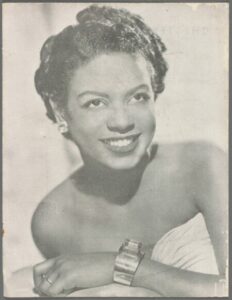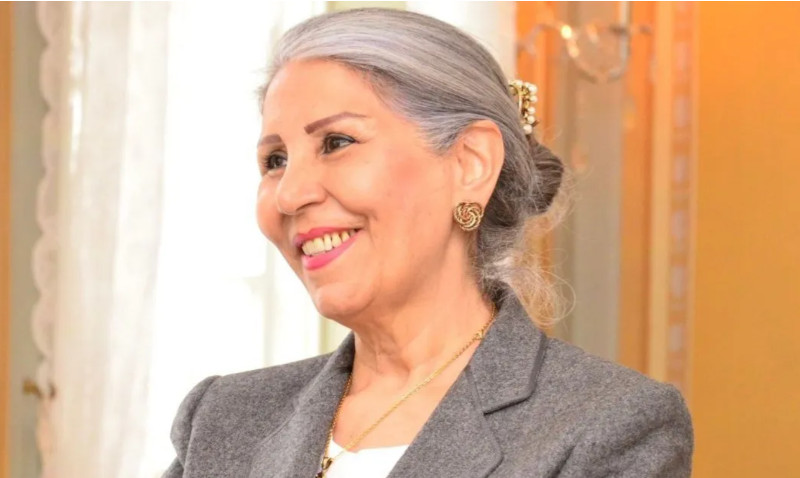 Hazel Scott, the sole survivor of her parents’ seven children, loved the piano from the time she was a very young child. Her mother, Alma, practiced and taught piano in their home in Port of Spain, Trinidad. The sound was as much a part of the child as was her breathing. Later, Hazel would call the piano “that marvel of marvels.” 1
Hazel Scott, the sole survivor of her parents’ seven children, loved the piano from the time she was a very young child. Her mother, Alma, practiced and taught piano in their home in Port of Spain, Trinidad. The sound was as much a part of the child as was her breathing. Later, Hazel would call the piano “that marvel of marvels.” 1
At three years old, when Hazel’s grandmother, Margaret, fell asleep one afternoon, Hazel wanted to play the hymn Margaret always sang at naptime. “I knew that somehow I could find ‘Gentle Jesus’ somewhere among those keys in front of me.” 2 That was exactly what she did, playing the melody with both hands. When her grandmother woke up, thinking that a student had come into the house to practice, she couldn’t believe her eyes. She called the whole neighborhood in, as well as Hazel’s mother, Alma, to witness this small miracle.
From then on, the piano was Hazel’s destiny. The women of the family moved to New York City when Hazel was four in search of a musical education and a career for the little girl. With lessons provided by her mother, Hazel had her first piano recital in Manhattan at the age of five. Three years later, Alma managed to talk Juilliard into auditioning the child. At the time, students were mostly white males sixteen or older. Here was little Hazel, whose feet didn’t reach the floor from the piano bench, improvising Rachmaninoff. The director of the school heard her and was aghast that anyone would dare to change the notes of the composer. Hazel was only improvising because her hands were too small to reach all the notes written in the piano score.
Professor Wagner, who was auditioning her, was not aghast. He couldn’t take her on as a formal pupil at Juilliard, but he offered to give her private lessons at the school. For ten years, he watched over her musical development.
Hazel continued to grow musically under his tutelage. By age 14, she joined her mother’s all-women band. By 15, she had a solo performance on the same bill at the Roseland Ballroom as the famous Count Basie Orchestra. Three years later, she had a role in a Broadway musical, Sing Out the News, and had begun to jazz up classical pieces, her signature style, at the well-known Yacht Club in New York. At age 19, Hazel was starring at Café Society, an integrated night club in New York City, as a stand-in for Billie Holiday. Soon, she was making recordings, began her film career, and became a household name.
As Hazel’s star rose, she was careful to pave the way for African American actors and musicians who would come after her. Her contracts stated that she would not play for segregated audiences. She refused to play roles of maids or women of questionable character in her films. She approved her own wardrobe and the music that she played in such movies as Something to Shout About, I Dood It, and Rhapsody in Blue. After four movies, her insistence on the filming of African American women in dignified clothing to send their men off to war, instead of wearing dirty aprons, caused the head of RKO Pictures in Hollywood, Harry Cohn, to cancel all future contracts with her. “She will never set foot in another movie studio as long as I live,” 3 he declared.
Hazel’s work did not suffer from her being thrown out of Hollywood. She returned to her career which included a return to Café Society, Carnegie Hall, more recordings, and concert tours. Her personal life was also thriving with her marriage to Adam Clayton Powell, Jr. In 1950, when she was 30 years old, she was given a weekly television show in which she was the sole performer, the first African American woman to have done so. What did cause her career to falter in the United States were accusations by the House Un-American Affairs Committee (HUAC) that she was a Communist. Though she testified in front of the committee, refuting their claims, she was blacklisted, along with many other artists and performers of the time.
Though Hazel and her husband had a son together, their marriage became unbearable, and Hazel moved to Paris with “Skipper” (Adam Clayton Powell III), to take advantage of the opportunities to play jazz in Europe. She stood up for the rights of African Americans while in France, demonstrating at the American Embassy to support Dr. Martin Luther King’s March on Washington. Dr. King stopped to see her in Paris and told her, “Come on home, Hazel, because there’s a whole generation of people growing up who have not been told of your contribution.” 4
In 1968, Hazel did return to the United States. She continued her stance for human rights along with acting in television talk shows and taking a permanent gig at Kippy’s, a restaurant in New York City where a room was set aside for her performances. Her friend Dizzy Gillespie, along with other Baha’i musician friends, had told her about the Baha’i Faith over the years. On December 1, 1968, she became a Baha’i. “All my life,” she said in an interview, “people have said to me, ‘The way you talk, you sound like a Baha’i,’ and I never knew what a Baha’i was . . . I have always respected everyone’s religion. As I say, there is only one God . . . That is what is great about Baha’i; we believe in Progressive Revelation. We believe that whenever man has been ready to absorb more knowledge, God has revealed it.” 5
Thirteen years later, Hazel Scott was playing at Kippy’s when she doubled over in pain and was rushed to the hospital where the doctors discovered pancreatic cancer. She died on October 2, 1981, while her friend, Dizzy Gillespie, played his trumpet softly in her room.
Note: You can read about the life of Hazel Scott in this book published by Bellwood Press (an imprint of the US Baha’i Publishing Trust) as part of its Changemaker series for children and junior youth: Hazel Scott: A Woman, A Piano and a Commitment to Justice
FOOTNOTES & CITATIONS
- Chilton, Karen. Hazel Scott: The Pioneering Journey of a Jazz Pianist from Café Society to Hollywood to HUAC. Ann Arbor, Michigan: The University of Michigan Press, 2008, p. 7
- Ibid., p. 7
- Ibid., p. 85
- Taylor, Anthony. Notes and Tones: Musician to Musician Interviews. New York, New York: Da Capo Press, 1993, pp. 259-60
- Ibid., pp. 257-58




